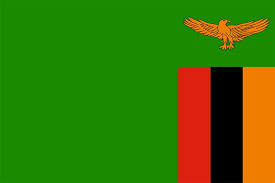Meaning of Colors of Zambian Flag
 What is the Meaning of Colors of Zambian Flag?
What is the Meaning of Colors of Zambian Flag?
The Zambian flag, with its distinctive colors and emblem, does more than symbolize the nation's natural wealth and historical struggles; it encapsulates the essence of Zambia's identity and its collective aspirations. As we delve deeper into the meanings behind the flag, it becomes evident how this national symbol fosters a sense of unity, pride, and hope among Zambians. This further exploration reveals the intricate layers of significance each element carries and how they contribute to the narrative of a nation poised between its rich traditions and its forward-looking aspirations
.
Meaning of Colors of Zambian Flag
Black: A Reflection of Unity and Diversity
The flag's composition—especially the inclusion of black to represent the people of Zambia—underscores the nation's commitment to unity in diversity. Zambia is home to a mosaic of ethnic groups, each with its unique traditions, languages, and cultural practices. The black color in the flag serves as a unifying emblem, reminding citizens that despite their diverse backgrounds, they share a common identity as Zambians. This sense of unity is crucial for the country's social cohesion and stability, promoting a collective effort towards national development.
Green: Environmental Stewardship
The prominence of green in the flag highlights Zambia's dedication to environmental conservation and sustainable development. In a world grappling with climate change and environmental degradation, the flag serves as a constant reminder of the importance of preserving natural resources for future generations. It underscores the government's and the people's responsibility towards maintaining the country's biodiversity, promoting green policies, and ensuring that economic development does not come at the expense of environmental health.
Orange: Economic Aspirations and Challenges
The orange stripe, symbolizing Zambia's mineral wealth, particularly copper, speaks volumes about the country's economic aspirations and the challenges it faces. While the mining sector has been a significant contributor to Zambia's economy, the flag also prompts a reflection on the need for economic diversification. It highlights the importance of investing in other sectors such as agriculture, tourism, and technology to ensure sustainable economic growth and reduce dependence on a single commodity.
Design
The Eagle's Soar: A Symbol of Ambition
The eagle in flight above the flag's stripes is perhaps the most potent symbol of Zambia's ambitions and the resilience of its people. It embodies the spirit of independence and sovereignty, reflecting the nation's desire to chart its course in the global arena. The eagle's upward trajectory is a metaphor for Zambia's growth and development aspirations, encouraging citizens to aim high and work tirelessly towards their goals. It serves as an inspiration for the youth, in particular, to pursue excellence and contribute to the nation's progress.
A Beacon of Hope and Resilience
Finally, the Zambian flag stands as a beacon of hope and resilience. It tells the story of a country that has overcome colonial oppression and is determined to face future challenges with courage and determination. The flag's colors and symbols remind Zambians of their shared history, the progress they have made, and the potential that lies ahead. It fosters a sense of national pride and optimism, encouraging citizens to remain resilient in the face of adversity and committed to building a prosperous future for Zambia.
Embracing Cultural Heritage and National Pride
Beyond its overt symbolism, the Zambian flag serves as a canvas upon which the nation's cultural heritage is proudly displayed. The colors and emblems on the flag resonate deeply with Zambians, evoking a sense of pride in their identity and heritage. The inclusion of black in the flag, for instance, is not merely a nod to the people of Zambia but also a celebration of the country's rich and diverse cultural tapestry. It serves as a reminder that Zambia's strength lies in its unity amidst diversity, and that every citizen, regardless of ethnicity or background, plays a vital role in shaping the nation's destiny.
Furthermore, the flag acts as a powerful tool for cultural diplomacy, representing Zambia on the global stage and showcasing its unique identity to the world. Whether displayed at international events, embassies, or on the uniforms of Zambian athletes, the flag serves as a potent symbol of the nation's values, traditions, and aspirations. It fosters a sense of belonging among Zambians living abroad and serves as a point of connection for the diaspora community, reinforcing their ties to their homeland
.
Inspiring Future Generations
In addition to its role in fostering national pride and unity, the Zambian flag also serves as an educational tool, inspiring curiosity and patriotism in future generations. Through the study of the flag's history and symbolism, young Zambians learn about their country's journey to independence, the sacrifices of their ancestors, and the values that underpin their national identity. The flag becomes more than just a piece of cloth; it becomes a symbol of hope, resilience, and the limitless possibilities that await the next generation of Zambian leaders, innovators, and changemakers.
Conclusion
The Zambian flag is more than a national emblem; it is a tapestry woven with the threads of Zambia's past, present, and future. Each color and symbol carries deep meanings, reflecting the country's values, aspirations, and commitments. As Zambia continues to navigate the complexities of the 21st century, its flag remains a source of inspiration and unity, reminding Zambians and the world of the nation's indomitable spirit and boundless potential.
